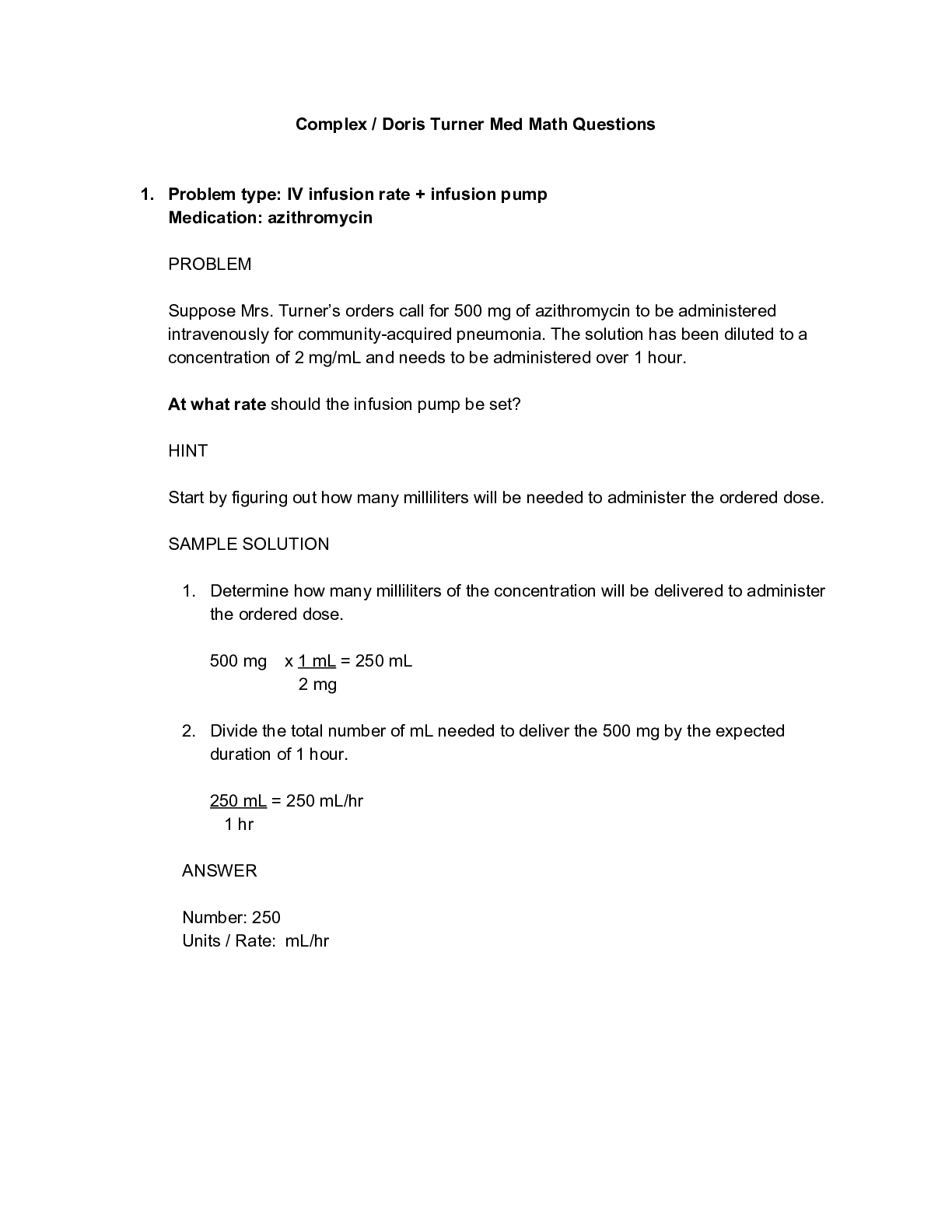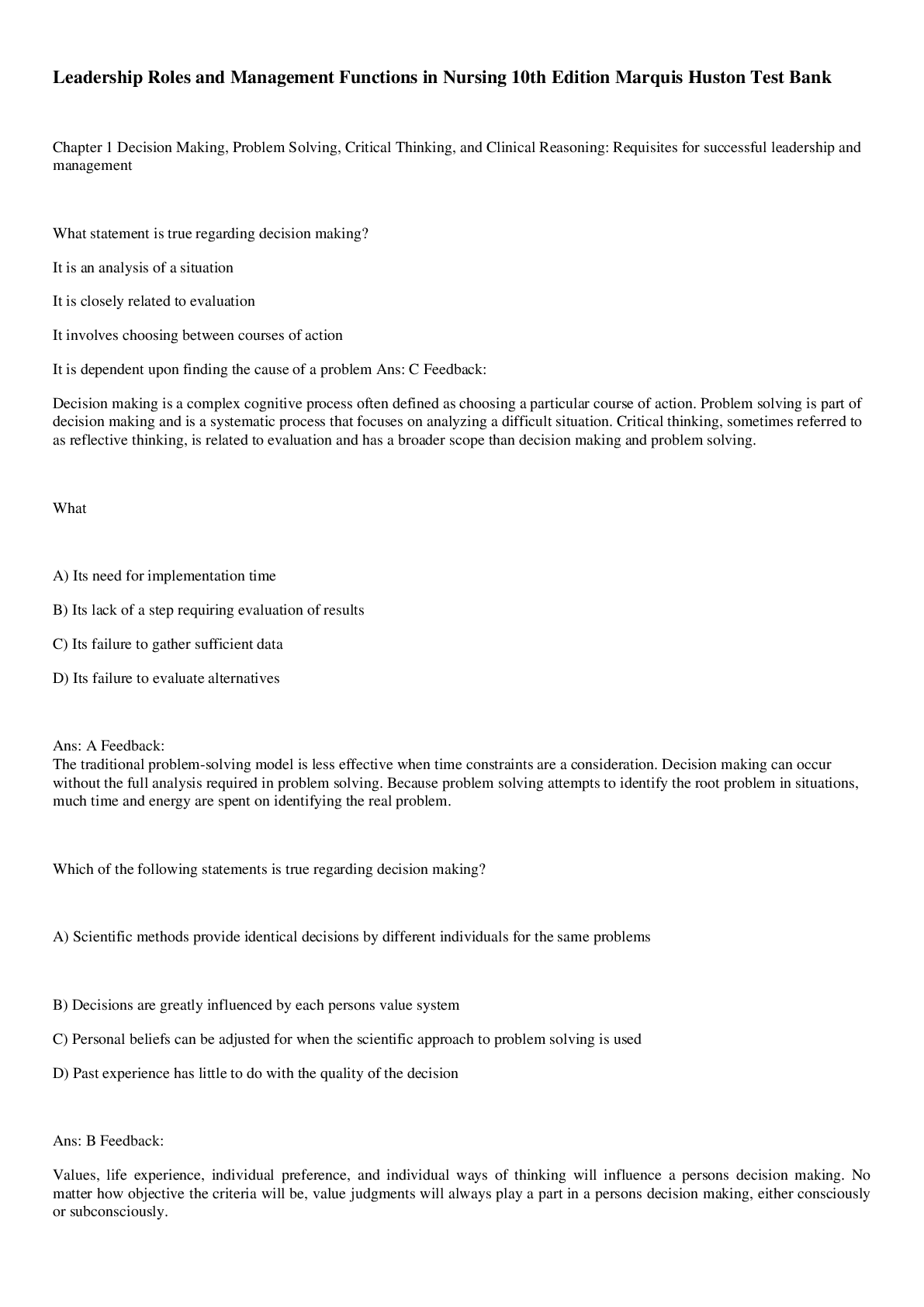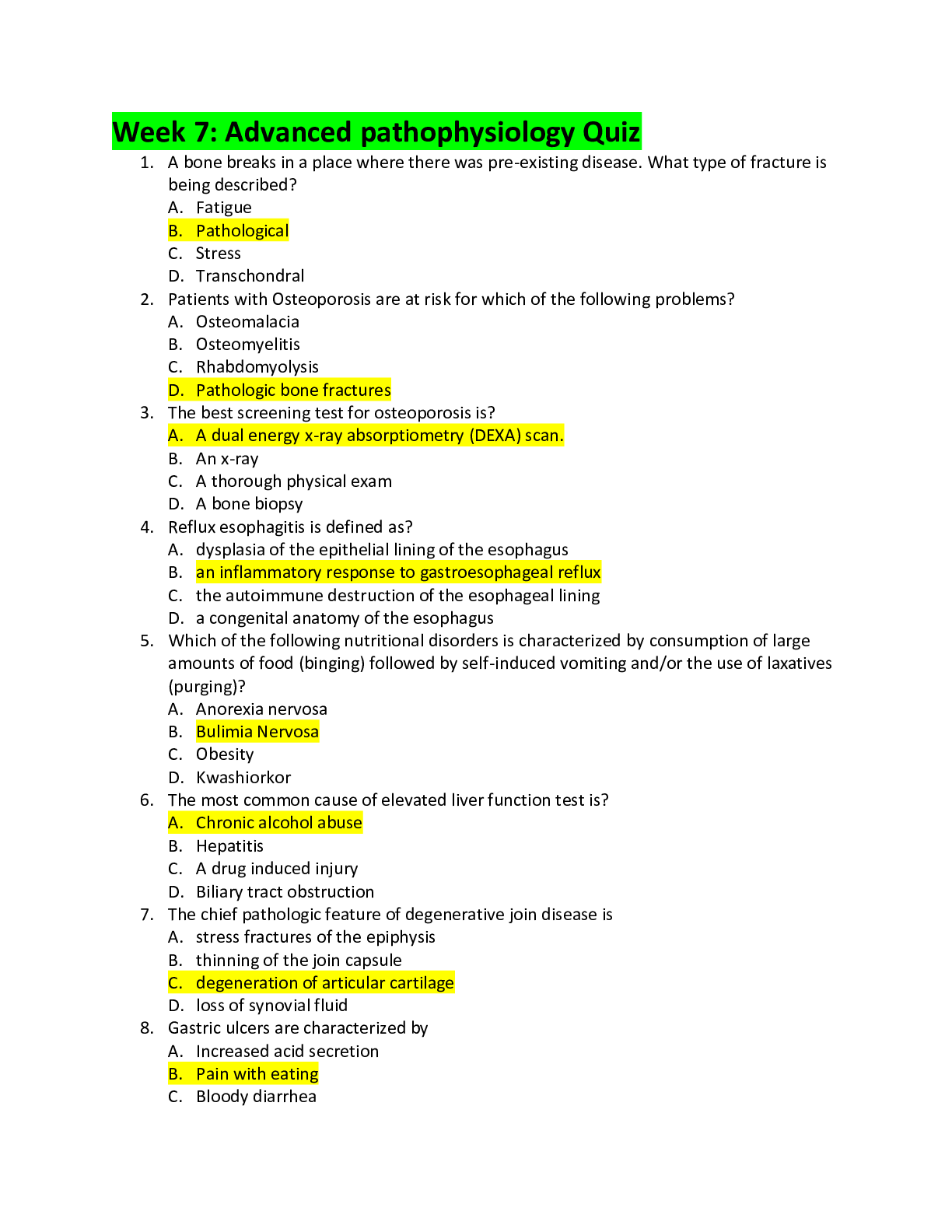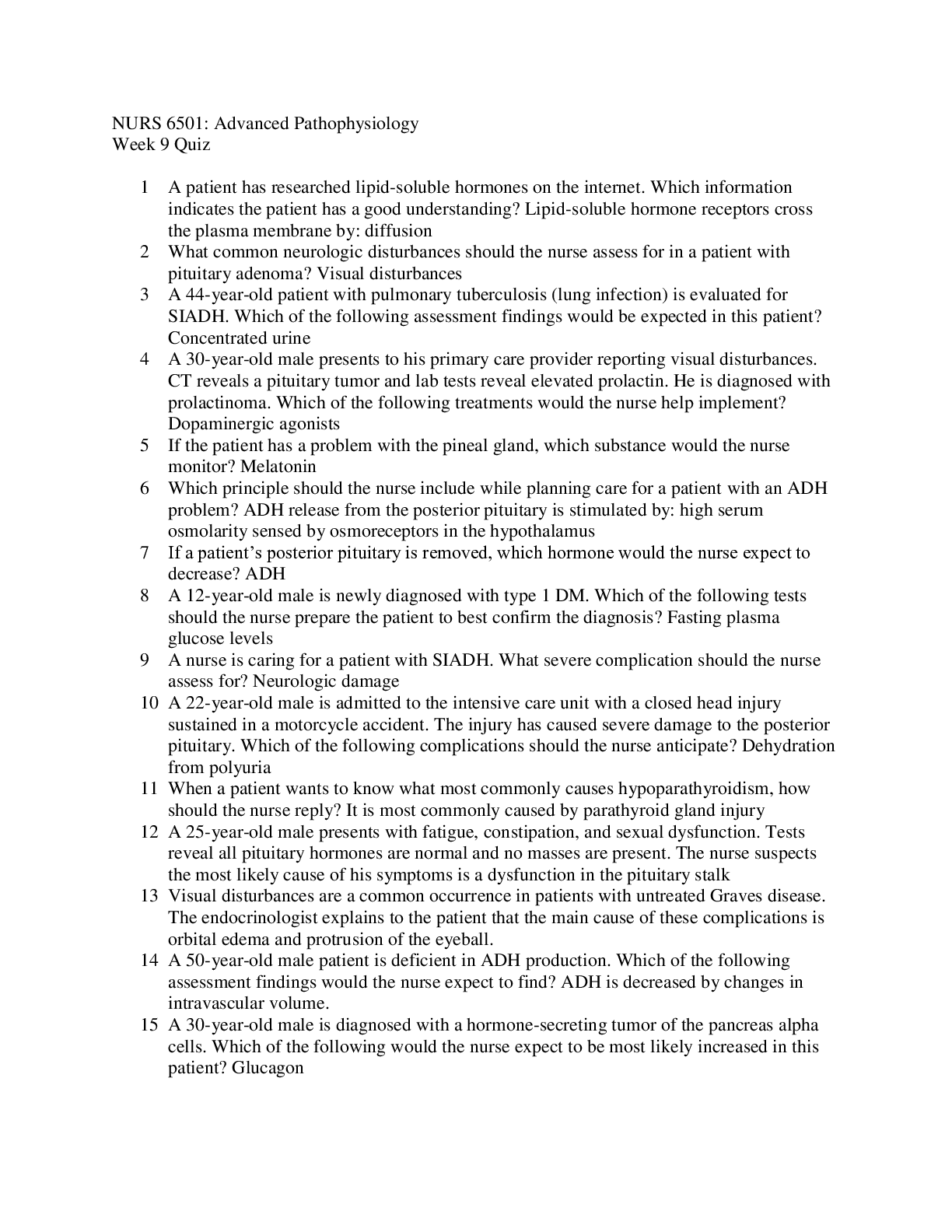*NURSING > QUESTIONS & ANSWERS > NR 507 Advanced Pathophysiology Quiz 2 – Real Exam Q & A(all correct answers) (All)
NR 507 Advanced Pathophysiology Quiz 2 – Real Exam Q & A(all correct answers)
Document Content and Description Below
Question 1 2 / 2 pts In hyperkalemia, cardiac rhythm changes are a direct result of Correct! cardiac cell hypopolarization. cardiac cell repolarization. cardiac cell hyperexcitability. ... depression of the sinoatrial (SA) node. If extracellular potassium concentration increases without a significant change in intracellular potassium, the resting membrane potential becomes more positive (i.e., changes from –90 to –80 mV) and the cell membrane is hypopolarized (the inside of the cell becomes less negative or partially depolarized [increase excitability]). (Electrical properties of cells are discussed in Chapter 1.) Question 2 2 / 2 pts Water movement between the intracellular fluid compartment and the extracellular compartment is primarily a function of plasma oncotic pressure. antidiuretic hormone. hydrostatic forces. Correct! osmotic forces. The movement of water between ICF and ECF compartments is primarily a function of osmotic forces. (Osmosis and other mechanisms of passive transport are discussed in Chapter 1.) Question 3 2 / 2 pts Chvostek sign and Trousseau sign indicate Correct! hypocalcemia. hyperkalemia. hypercalcemia. hypokalemia. Two clinical signs are Chvostek sign and Trousseau sign. Question 4 2 / 2 pts Physiologic pH is maintained around 7.4 because bicarbonate (HCO3) and carbonic acid (H2CO3) exist in a ratio of Correct! 20:1. 10:5. 10:2. 1:20. The relationship between bicarbonate and carbonic acid is usually expressed as a ratio. When the pH is 7.40, this ratio is 20:1 (bicarbonate/carbonic acid). Question 5 2 / 2 pts What is a major determinant of the resting membrane potential necessary for transmission of nerve impulses? The ratio between intracellular Na+ and extracellular K+ The ratio between intracellular K+ and extracellular Na+ Correct! The ratio between intracellular K+ and extracellular potassium The ratio between intracellular Na+ and extracellular sodium The ratio of K+ in the ICF to K+ in the ECF is the major determinant of the resting membrane potential, which is necessary for the transmission and conduction of nerve impulses, maintenance of normal cardiac rhythms, and skeletal and smooth muscle contraction. Question 6 2 / 2 pts Why are infants susceptible to significant losses in total body water (TBW)? Because they are unable communicate adequately when they are thirsty Correct! Because an infant’s kidneys are not mature enough to counter fluids losses Because infants have a slow metabolic rate Because more than half of an infant’s body weight is water Infants are particularly susceptible to significant changes in TBW because of their high metabolic rate and the accelerated turnover of body fluids caused by their greater body surface area in proportion to total body size. Loss of fluids from diarrhea can represent a significant proportion of body weight. Renal mechanisms that regulate fluid and electrolyte conservation may not be mature enough to counter the losses, so dehydration may develop rapidly. Question 7 2 / 2 pts Which enzyme is secreted by the juxtaglomerular cells of the kidney when circulating blood volume is reduced? Aldosterone Correct! Renin Angiotensin II Angiotensin I When circulating blood volume or blood pressure is reduced, renin, an enzyme secreted by the juxtaglomerular cells of the kidney, is released in response to sympathetic nerve stimulation and decreased perfusion of the renal vasculature. Question 8 2 / 2 pts Which pleural abnormality involves a site of pleural rupture that act as a one-way valve, permitting air to enter on inspiration but preventing its escape by closing during expiration? Open pneumothorax Correct! Tension pneumothorax Secondary pneumothorax Spontaneous pneumothorax In tension pneumothorax, the site of pleural rupture acts as a one-way valve, permitting air to enter on inspiration but preventing its escape by closing up during expiration. As more and more air enters the pleural space, air pressure in the pneumothorax begins to exceed barometric pressure. Question 9 2 / 2 pts Clinical manifestations of pulmonary hypertension include Correct! peripheral edema and jugular venous distention. dyspnea on exertion and paroxysmal nocturnal dyspnea. systemic blood pressure greater than 130/90. productive cough and rhonchi bilaterally. Symptoms of fatigue, chest discomfort, tachypnea, and dyspnea on exertion, palpitations, and cough are common. Examination may reveal peripheral edema, jugular venous distention, a precordial heave, and accentuation of the pulmonary compartment of the second heart sound. Question 10 2 / 2 pts In ARDS, alveoli and respiratory bronchioles fill with fluid as a result of the compression on the pores of Kohn, thus preventing collateral ventilation. increased capillary permeability, which causes alveoli and respiratory bronchioles to fill with fluid. Correct! inactivation of surfactant and the impairment of type II alveolar cells. increased capillary hydrostatic pressure that forces fluid into the alveoli and respiratory bronchioles. Lung inflammation and injury damages the alveolar epithelium and the vascular endothelium. Surfactant is inactivated, and its production by type II alveolar cells is impaired as alveoli and respiratory bronchioles fill with fluid or collapse. [Show More]
Last updated: 1 year ago
Preview 1 out of 12 pages
Instant download
.png)
Buy this document to get the full access instantly
Instant Download Access after purchase
Add to cartInstant download
Reviews( 0 )
Document information
Connected school, study & course
About the document
Uploaded On
Oct 23, 2020
Number of pages
12
Written in
Additional information
This document has been written for:
Uploaded
Oct 23, 2020
Downloads
0
Views
33










 (1).png)













